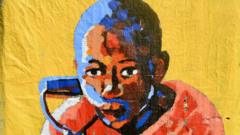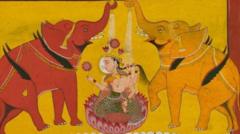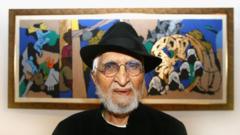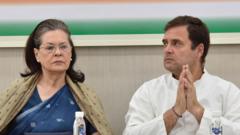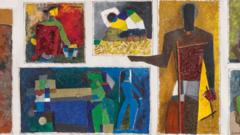A court in Delhi has authorized the seizure of two controversial paintings by renowned artist MF Husain, raising concerns about rising intolerance toward artistic expression in India.
India Court Orders Seizure of Controversial MF Husain Paintings
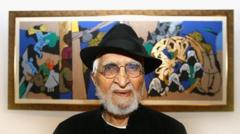
India Court Orders Seizure of Controversial MF Husain Paintings
Delhi court's decision to seize artworks sparks debate on artistic expression and religious sentiments.
The court in New Delhi has taken a controversial step, ordering the seizure of two paintings by celebrated artist MF Husain. The ruling comes after a complaint alleging that the artworks, showcased at the Delhi Art Gallery (DAG), depict Hindu deities in a manner that "hurt religious sentiments." The paintings in question, part of the ongoing exhibition "Husain: The Timeless Modernist," were displayed from October 26 to December 14, and include images of Hindu gods Ganesha and Hanuman alongside nude female figures.
Husain, who passed away in 2011 at the age of 95, frequently faced backlash for his radical portrayal of religious figures, often drawing ire from conservative groups for his use of nudity in art. In this incident, the complainant, lawyer Amita Sachdeva, documented the contentious pieces during her visit to the gallery and filed a police complaint shortly thereafter. Interestingly, upon a visit with the police investigating officer, the paintings reportedly could not be found, with gallery officials claiming they had never exhibited them.
The Delhi Art Gallery has stated it is not involved in the legal proceedings and is currently seeking legal advice on the matter. The judge acknowledged the inquiry's findings that the exhibition was private and aimed to celebrate the artist's work. Husain's legacy as one of India’s foremost painters is shadowed by controversies surrounding his artwork, leading him to spend years in self-imposed exile.
In a bid for clarification and possible accountability, Sachdeva has requested that surveillance footage from the gallery’s CCTV be preserved to verify the exhibition's claims. This case emerges against a backdrop of increasing scrutiny of artistic freedoms in the country, highlighted by previous incidents where works by renowned artists were subjected to censorship and legal challenges.
The Delhi court's ruling has broader implications, reflecting a growing tension in India about religious sensitivities versus the freedom of artistic expression, an issue that has been contentious within society. Observers note that recent court decisions have acknowledged artistic nudity as a common element of Indian iconography, raising questions about the limits of artistic representation in a diverse society.
Husain, who passed away in 2011 at the age of 95, frequently faced backlash for his radical portrayal of religious figures, often drawing ire from conservative groups for his use of nudity in art. In this incident, the complainant, lawyer Amita Sachdeva, documented the contentious pieces during her visit to the gallery and filed a police complaint shortly thereafter. Interestingly, upon a visit with the police investigating officer, the paintings reportedly could not be found, with gallery officials claiming they had never exhibited them.
The Delhi Art Gallery has stated it is not involved in the legal proceedings and is currently seeking legal advice on the matter. The judge acknowledged the inquiry's findings that the exhibition was private and aimed to celebrate the artist's work. Husain's legacy as one of India’s foremost painters is shadowed by controversies surrounding his artwork, leading him to spend years in self-imposed exile.
In a bid for clarification and possible accountability, Sachdeva has requested that surveillance footage from the gallery’s CCTV be preserved to verify the exhibition's claims. This case emerges against a backdrop of increasing scrutiny of artistic freedoms in the country, highlighted by previous incidents where works by renowned artists were subjected to censorship and legal challenges.
The Delhi court's ruling has broader implications, reflecting a growing tension in India about religious sensitivities versus the freedom of artistic expression, an issue that has been contentious within society. Observers note that recent court decisions have acknowledged artistic nudity as a common element of Indian iconography, raising questions about the limits of artistic representation in a diverse society.


